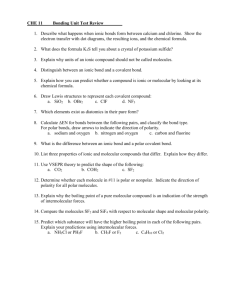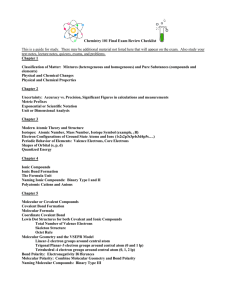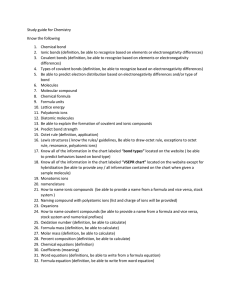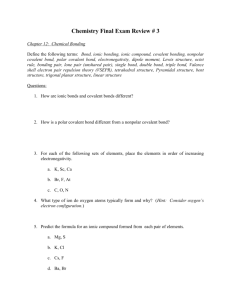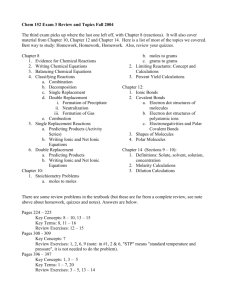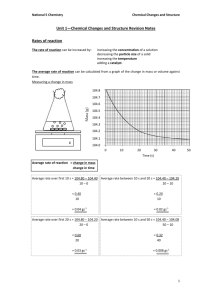Chemistry 111: Exam 1 Topics
advertisement
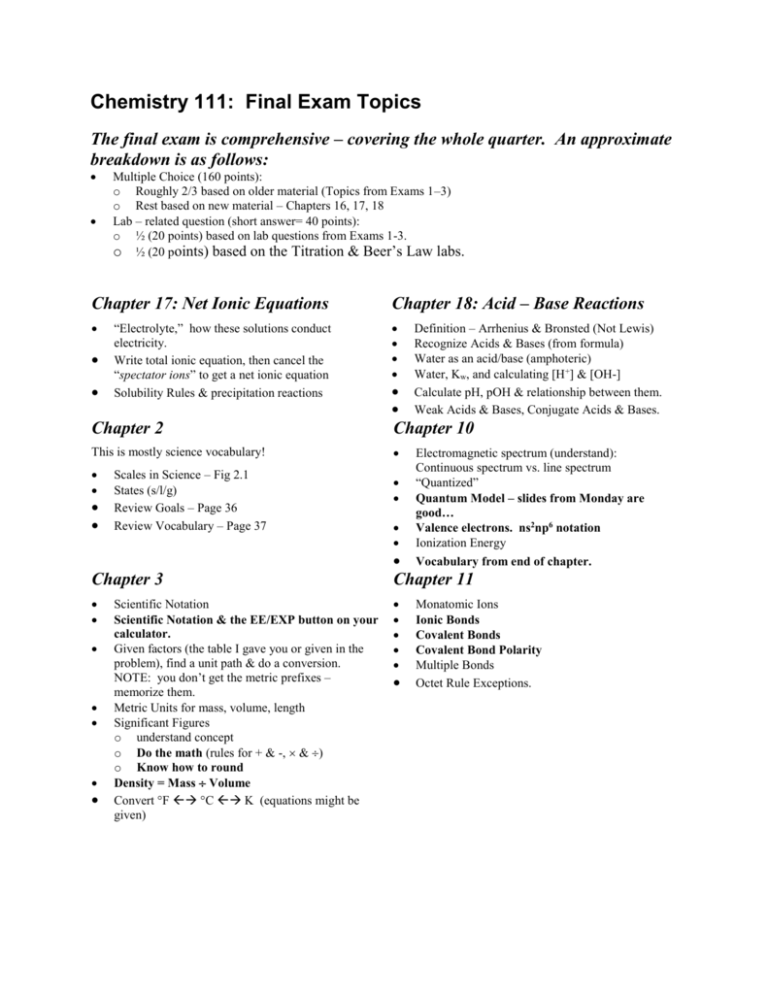
Chemistry 111: Final Exam Topics The final exam is comprehensive – covering the whole quarter. An approximate breakdown is as follows: Multiple Choice (160 points): o Roughly 2/3 based on older material (Topics from Exams 1–3) o Rest based on new material – Chapters 16, 17, 18 Lab – related question (short answer= 40 points): o ½ (20 points) based on lab questions from Exams 1-3. o ½ (20 points) based on the Titration & Beer’s Law labs. Chapter 17: Net Ionic Equations Chapter 18: Acid – Base Reactions “Electrolyte,” how these solutions conduct electricity. Write total ionic equation, then cancel the “spectator ions” to get a net ionic equation Solubility Rules & precipitation reactions Definition – Arrhenius & Bronsted (Not Lewis) Recognize Acids & Bases (from formula) Water as an acid/base (amphoteric) Water, Kw, and calculating [H+] & [OH-] Calculate pH, pOH & relationship between them. Weak Acids & Bases, Conjugate Acids & Bases. Chapter 2 Chapter 10 This is mostly science vocabulary! Scales in Science – Fig 2.1 States (s/l/g) Review Goals – Page 36 Review Vocabulary – Page 37 Electromagnetic spectrum (understand): Continuous spectrum vs. line spectrum “Quantized” Quantum Model – slides from Monday are good… Valence electrons. ns2np6 notation Ionization Energy Vocabulary from end of chapter. Chapter 3 Chapter 11 Scientific Notation Scientific Notation & the EE/EXP button on your calculator. Given factors (the table I gave you or given in the problem), find a unit path & do a conversion. NOTE: you don’t get the metric prefixes – memorize them. Metric Units for mass, volume, length Significant Figures o understand concept o Do the math (rules for + & -, & ) o Know how to round Density = Mass Volume Convert °F °C K (equations might be given) Monatomic Ions Ionic Bonds Covalent Bonds Covalent Bond Polarity Multiple Bonds Octet Rule Exceptions. Chapter 5 Chapter 12 Dalton’s Rules Protons, neutrons, electrons. Plum Pudding & Nuclear Model, Rutherford Experiment & it’s conclusions Isotopes, Nuclear Symbols Average Atomic Mass (weighted sum) AMU vs. g/mol Periodic Table Trends Chapter 6 Names of Cations for elements (metals) Names of Anions for element (nonmetals) Names of covalent compounds from formula Formulas of covalent compounds from name. Names of ionic compounds Formula of ionic compounds. Transition metal ions: o Formula from Stock system name for any element o ion from stock system name for any element o know charges of selected elements (see class notes) o Common names (ferric ion = Fe3+, ferrous = Fe2+) o Understand Hg2+ = mercury(II) ion, Hg22+ = mercury(I) ion Polyatomic Ions o Oxyanions o CN-, CH3COO-, … o H3O+, NH4+ o HPO42-, HCO3-, … Some common names: NH3, H2O Oxyacids – HNO3 = nitric acid (-ate-ic, …) Be able to draw a Lewis structure. Molecular Geometry o How many VSEPR pairs (electron domains are there?) o What is the VSEPR shape? o What is the angle? o What is the molecular shape (when there are lone pairs) o What is the angle when there are lone pairs? Bond Polarity (applied to next item) Molecular Polarity o Sum up the bond dipoles to decide if a molecule is polar. o Good examples: CH4, CH2F2, CO2, H2S, CH3F Chapter 4 Understand kinetic theory – explain pressure/temp/volume based on molecular collisions Understand how to read a barometer Understand how to read a manometer Be able to convert pressure units Remember to use Kelvin! Understand what’s held constant in Boyle’s Law, Charles’ Law Use combined gas law (P1V1/T1=P2V2/T2 is given). Chapter 13: Ideal Gas Law (PV=nRT) Recognize that you have to solve this type of problem – should have 4 out of 5 gas variables. Set up a table to solve the problem! Be able to use equation for gas density. Use n=PV/RT for stoichoimetry (ugh) Sometimes cheat - @ STP have 22.4 L/mol of any gas Chapter 7 Calculate molecular weight Understand moles. Determine % composition Determine empirical formula from % composition (for above 2, use my table method!) Chapter 15: Gases, Liquids & Solids Chapter 8 Balance chemical equations Write chemical equations from descriptions. Get mole ratios from balanced equations Partial Pressure Intermolecular Forces (IMF) o Dipole-Dipole o London Dispersion (Induced Dipole) o Hydrogen Bond o Figure 15.9! Know viscosity, boiling point, Hvap, surface tension, vapor pressure. Relate the above to IMF Types of solids – what holds them together (ionic bond, covalent bond, or IMF?) Calculate heat for temperature changes. Know reactions from in class Chapter 9 Chapter 16: Solutions Mass calculations (massmolesmolesmass) You will have the map on the exam cover sheet! Find % yield Use % yield as a conversion factor Vocabulary Formation of a solution – NaCl hydrated Na+ & Cl IMF & Solubility Concentration Units o % (g/100g) o ppm (mg/L) o Molarity (mol/L) Dilution (M1V1=M2V2) Solution Stoichiometry – Conc (M) Volume (L) = moles Titration (2 cases only): o Easy – 1:1 stoichiometry, M1V1=M2V2 Lab: 1:1 stoich, find MW
